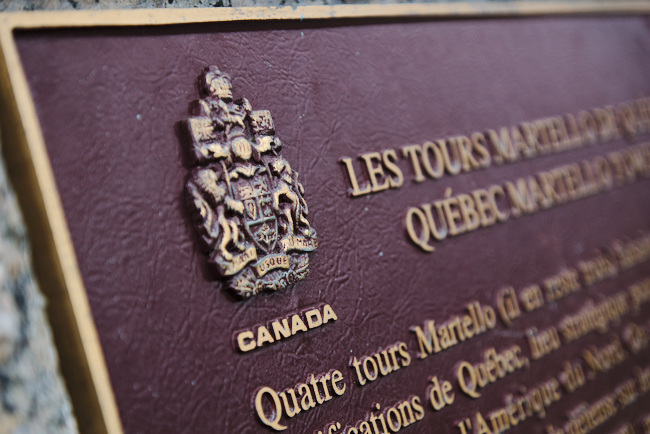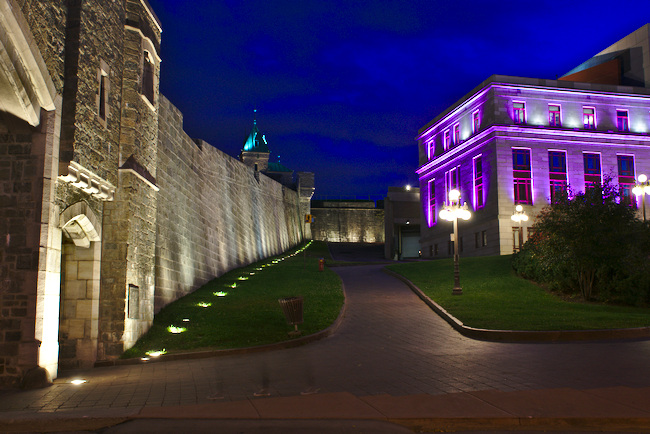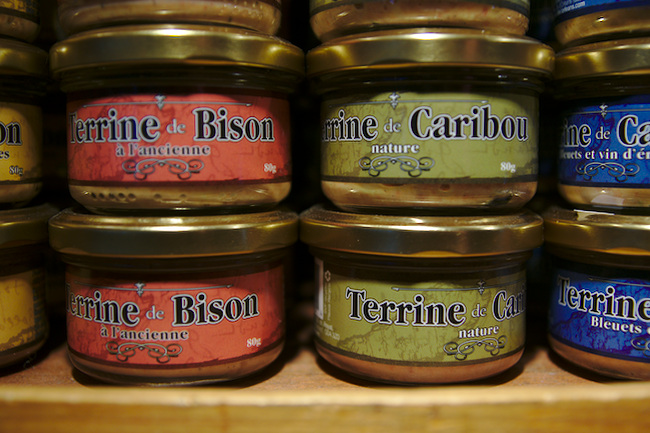- Travel + Photos
- Voyages
- Quebec
Québec

For my vacations, I usually pick an exotic destination or somewhere far away. This year? Oh... Canada (not to be confused with the national anthem Ô Canada), or Québec (city) to be more exact. It's nice to visit a francophone city for a change.
A bit of history
Jacques Cartier was the first European explorer to set foot in Québec in 1535, but it's not until 1608 that Samuel de Champlain established a permanent settlement in the town, called Kébec, an Algonquin word meaning "where the river narrows". Indeed, when going up the river from the Atlantic Ocean, the Saint Lawrence River narrows at the proximate of Cape Diamond, the foundation place of the city. Québec was then the capital of New France, a French colony. In 1759 the city was conquered by the British and in 1763 New France was ceded to the Britain at the end of the Seven Year's War and became a British colony.
With the increasing unrest in the colonies to the south, that would eventually grow into the American Revolution, the Quebec Act was enacted in 1774 in order to encourage the loyalty of the Canadians, still mostly French-speaking, to the British crown. Thereby they regain the practice of their customs and some other civil rights such as the use of the French language. But the political balance changes with the massive arrival of Loyalists fleeing the now United States to Québec. Unsatisfied with the rights granted to the Canadians, they soon petition the government to be allowed to use the British legal system they were used to in the American colonies. And with the Constitutional Act of 1791, the Province of Québec is divided in two: Upper Canada with a majority of Anglo-Protestant population with their British legal system and Lower Canada with a majority of Franco-Catholic population.
In 1837, the rebellion of the Patriots took place in Lower Canada in an attempt to end to the unilateral control of the British governors. After the rebellion, which were brutally repressed, the British Parliament reevaluates the situation and decides to merge Upper Canada and Lower Canada into one single colony, the Province of Canada, in 1840 with the Act of Union. Massive immigration from the British Isles in the following years creates more tensions between English Canadians and French Canadians or "Canadians of Old ". In the 1860s, negotiations between the colonies of British North America yield to the Canadian Confederation in 1867 with the British North America Acts which creates the Dominion of Canada and its four founding provinces: New Brunswick, Nova Scotia, Ontario and Québec (the latter two come from the splitting of the Province of Canada)
Of course, this summary of the history is incomplete and probably contains some inaccuracies, but it does highlight the main events that define Québec and its culture (described further below).
The city
With more than 400 years of history, Québec has collected a lot of distinctions. It is North America's only walled city north of Mexico City. It has seen the continent's first parish church, first museum, first stone church, first Anglican cathedral, first French-language university. Québec was the capital of New France, of Lower Canada, and for a short time it was the capital of the Province of Canada. Since 1867, it is the national capital of the Province of Québec. In 1985, UNESCO declared the Old Quebec (Vieux-Québec) a World Heritage site.
The cliffs of Cape Diamond (Cap Diamant) naturally divides Québec into Upper Town (Hate-Ville) and Lower Town (Basse-Ville). Lower Town develops at the foot of Cape Diamond and is in direct contact with the Saint Lawrence River, whereas Upper Town sits atop the cliffs on the plateau Québec-Sainte-Foy (colline de Québec) whose extremity is the Cape Diamond. The cape owes its name to the glittering stones on its cliffs. Jacques Cartier thought the stones could contain diamonds and brought samples back to France in 1542. Experts concluded that these diamonds were actually quartz, hence the French proverb "faux comme un diamant du Canada" (fake like a Canadian diamond)
The ramparts of the walled city are built atop the cliffs of Cape Diamond, for better defending the city of course. Contrarily to Paris where only the names of the gates still exists, one can only enter the walled city through the ramparts at a certain number of gates. Old Quebec is very touristy; in October, waves of tourists come and goes in rhythm with cruses ships docking at the port. Getting out of Old Quebec going westward to residential districts such as Saint-Roch, tourists become rare and one can see the day-to-day life of Quebecois. These districts are also more lively at night, whereas the streets of Old Quebec become empty after 8:30 pm.
The city has a tradition of street performing. In the summer, the many artists create a cheerful universe in the streets of Québec. Cirque du Soleil, which was founded in Baie-Saint-Paul 90 km outside of Québec, offers a free spectacle in the streets of Old Quebec in Lower Town every evening. However in October, the spectacles dry up and only some musicians perform in the streets.
The culture
In Québec, there is no attachment to England nor to France, just a heritage of the British governance system and the French culture. (The period of British colony is not necessarily seen as a bad thing). However, there is a strong attachment to the French language, which could probably be explained by the needs for defending their identity because of the discrimination against French-speaking Canadian after the Patriots rebellion of 1837 and the massive immigration of British afterwards. On television, news anchors hardly use any English words at all. That's how I learned some new French words for the equivalent English words that one uses in France. For instance, Quebecois use stationnement for parking, rouleau for a putt in golf, caler la coupe for hole out, le vert (literal translation) for the green, quart-arrière (literal translation) for quarterback in American football, touché for touchdown etc. In fact, the only official language in Québec is French.
Being right next to the United States, there is a certain American influence in Québec. Most of the cars are from across the border. Some of the American networks like ABC, CBS and NBC, are available on television. Baseball is widely followed, maybe because Toronto was in the playoff at the time. To a lesser degree, American football is followed as well. But their sport is indisputable ice hockey.
With its population becoming older, Québec has recently set a politics encouraging immigration. There are two rules that all new immigrants have to comply with: speaking the French language and obey to all laws in Québec. After that, they are free to practise their religion and maintain their customs. That said, there is not a great ethnic diversity in Québec City, contrarily to Montréal. More than 95% of the population in Québec (city) is francophone, whereas the Montréal metropolitan has 22% of allophones and 12.5% of anglophones.
Practical details
Dates of the trip: 6 - 13 October 2015
There is no public transit from the airport to city centre. The best way is by taxi, which has a fix price for city centre.
Most restaurants offer a "table d'hôte" menu. It's a fix price menu of usually 3 courses and some times with a drink. That's the most economic menu.
City bus line 808 goes to Parc the la Chute-Montmorency. From Québec, take the bus to the last stop, then the little dirt trail to the left that leads to the top of the fall. It's less than 100 m away from the bus stop.
A visit to the Musée de la civilisation is a must if you want to learn about the history of Québec; it's very interesting. I spent half a day there, in part to avoid the torrential rain on that day.
According to the locals, the best view of Québec city is not from the other side of the river in Lévis. But if you have time to spare, it's worth taking the ferry to Lévis - that's the cheapest way to see Québec from the Saint-Lawrence River without taking a cruise - and strolling on the Terrasse de Lévis.
Copyright © 2015, Northwest Summit. All rights reserved.
No part of this page may be reproduced, republished or copied without the express written permission of its author.


